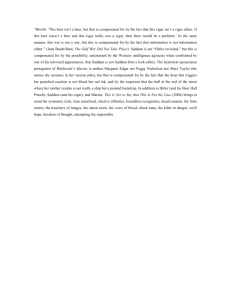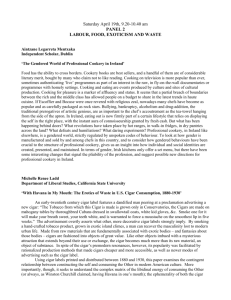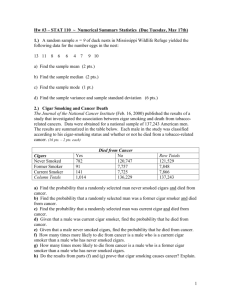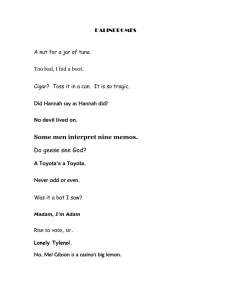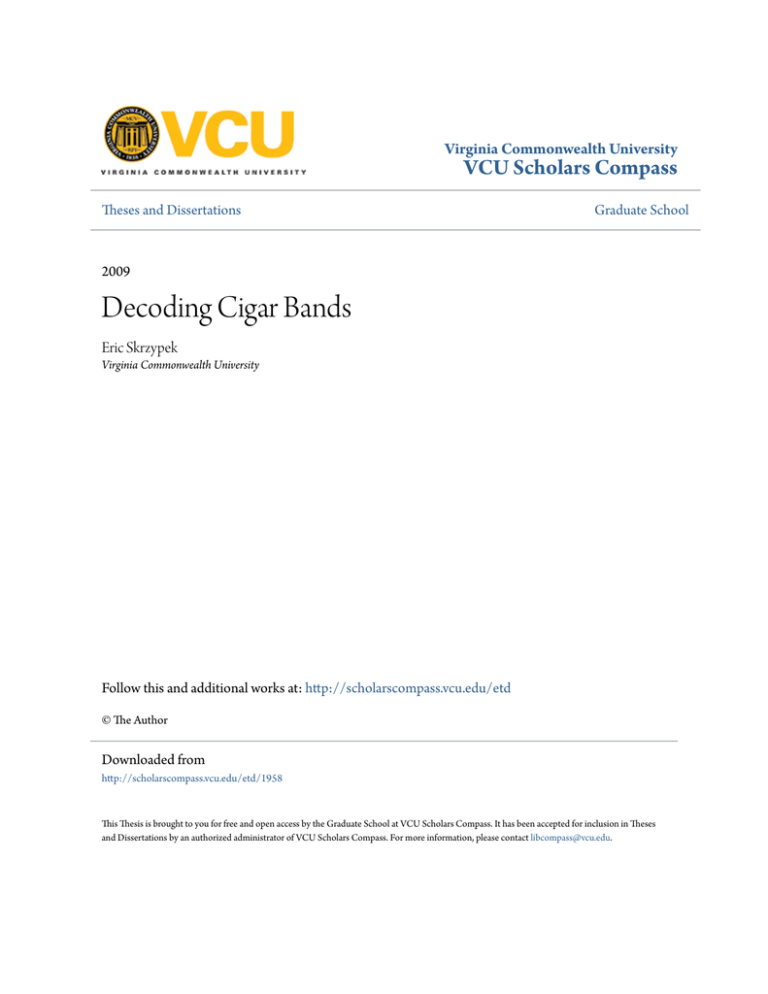
Virginia Commonwealth University
VCU Scholars Compass
Theses and Dissertations
Graduate School
2009
Decoding Cigar Bands
Eric Skrzypek
Virginia Commonwealth University
Follow this and additional works at: http://scholarscompass.vcu.edu/etd
© The Author
Downloaded from
http://scholarscompass.vcu.edu/etd/1958
This Thesis is brought to you for free and open access by the Graduate School at VCU Scholars Compass. It has been accepted for inclusion in Theses
and Dissertations by an authorized administrator of VCU Scholars Compass. For more information, please contact libcompass@vcu.edu.
Decoding Cigar Bands
Documentation submitted in partial fulfillment of the requirements for the degree
of Master of Interdisciplinary Studies at Virginia Commonwealth University.
by
Eric A. Skrzypek
Bachelor of Science, Indiana University of Pennsylvania, Indiana, PA, December
2005
Virginia Commonwealth University
Richmond, Virginia
December, 2009
Table of Contents
Artist Statement ................................................................................................... iii
Introduction ...........................................................................................................1
Artistic and Historic Influences..............................................................................2
Artistic Influences..................................................................................................5
Symbolism ............................................................................................................7
Use of Design .....................................................................................................11
Conclusion ..........................................................................................................12
Bibliography ........................................................................................................14
Appendix.............................................................................................................15
List of Images .....................................................................................................15
Images ................................................................................................................16
Resume ..............................................................................................................26
ii
Artist Statement
I have always admired the aesthetics found in cigar labels – the intricate
details, gentle curves, and bright colors seem to have a special story to tell.
However, most of the time this story goes untold as labels are given a quick
glance, then thrown away with the ashes. As a cigar smoker myself, my artistic
pursuit has been to bring to life the stories of my cigar labels. I aim to reach out
to those who readily identify with the subject matter, and provide them with a new
perspective from which to view the labels most now simply toss aside. For those
who have never taken an interest in cigars, I hope to inspire an appreciation for
the history and aesthetic beauty of cigar labels through my interpretive work.
iii
Decoding Cigar Labels
Introduction
Ever since I graduated from college, I have had a strong desire to pursue
a master’s degree. When I started working, I began to miss the various studio
classes I had taken in college that had served as an outlet for my creative energy
and allowed me to grow as an artist. I first heard about the Master of
Interdisciplinary Studies (M.I.S.) program offered by Virginia Commonwealth
University at an Arlington Art Teachers’ meeting and it sounded like a perfect
opportunity. Colleagues spoke highly of the program, the quality of the instructors
and the flexibility of class schedules that allowed them to fit the program into their
busy lives. After doing additional research on my own, I decided to give the
program a try and I loved it.
The M.I.S. program has given me the opportunity to explore my passions
and allowed me to combine two of my favorite activities, collecting cigars and
making art, in a way I never dreamed possible. Through the guidance of many
patient professors and supportive peers, I was able to draw out the artistic beauty
I saw in cigar bands, and transform it in a way that was uniquely my own. The
following chronicles that journey and my attempt to artistically decode the beauty
and symbolism of cigar bands.
1
Artistic and Historic Influences
When I first started collecting cigar labels, I had no idea where it would
lead me. Something about seeing the labels carelessly discarded in an ashtray
did not sit well and the collector in me decided it would be better to save them
instead. However, when I looked closely at the labels I started to see something
more than just insignificant pieces of paper. It dawned upon me that the labels
themselves were small works of art with their own stories, and that I could share
these stories with others through my artwork.
My work is inspired primarily by cigar bands. There is a difference
between cigar labels and cigar bands. Technically, labels are the small square
artwork on the inside lid of a cigar box, while cigar bands are the individual
pieces of paper wrapped around each cigar that denote the brand name of the
cigar.
Cigar label art has a rich history. The labels first became mainstream
shortly after the American Civil War when the government was looking for ways
to raise revenue to cover the costs it had incurred during the war. Politicians
quickly noticed a huge untaxed industry as a potential source of much needed
revenue. As a result of this new tax, cigar manufacturers were required to place a
stamp on their products and soon began to use this stamp as a way to
distinguish and brand their products. The stamps were made of thin strips of
paper attached to the cigars and cigar boxes.
2
This great boom in branding and marketing was heightened by the
invention of stone lithography. This process, created in 1798 by Aloys
Senfelder, was the main medium for early cigar label art. This unique state-ofthe-art printing process allowed for the highest level of detail, and also allowed
for relatively easy mass production while maintaining the artistic integrity of the
design. Another distinguishing point of stone lithography was the flat printing
surface. Usually printing blocks had a relief that allowed the ink to rest on a
raised surface. However, with lithography there was no such relief, and printing
was achieved on a flat surface by using grease to create a barrier. This method
allowed for greater detail to show through in the finished product. Once the
grease was applied to create the desired design, ink was then placed onto the
negative space. When the paper was pressed, the ink was absorbed by the
paper and the design was transferred to the cigar label. The paper was then cut
into squares and placed inside the lid of the cigar box.
Chromolithography (color printing) was soon developed and was used by
cigar manufacturers to enhance branding and marketing efforts. Some prints
produced by these manufacturers used as many as forty separate stones to
achieve various color combinations. During and after the printing process, artists
incorporated techniques such as embossing, imitation brush strokes, lacquering,
hand stippling, and hand applied 24 karat gold leaf to enhance the print. A
finished cigar label design could take thirty days to create and involve a dozen
highly skilled specialists, resulting in a production cost of over $6000 in the early
3
1900’s.
Once the printing process was complete, the stones were ground down
and reused. This has made the labels still in existence one-of-a-kind limited
editions. The labels produced by stone lithography range in size from 4”x4” to
8”x8”, and depending on the quality and rarity, could cost over $1000 each in
today’s market. The subjects of these intricate works of art have varied over the
years and are like visual history books chronicling important events, popular
cultural icons, and political figures. Regardless of the subject matter one thing is
certain, as Wayne Dunn, contemporary cigar label enthusiast said, “the
magnificent depth and luminescence of these Victorian ephemera will not pass
our way again. The quality of stone lithography has never been duplicated and
never will be” (Dunn, 9).
Understanding the rich history of cigar label art has allowed me to better
appreciate the work, details, and beauty that exist in each label. When I first
began on this path, my interest in labels was similar to a popular hobby from the
early 1900s, collecting the cigar bands that are often thrown to the ground or left
in the ashtray. However, as my collection grew, I became more aware of the
artistic qualities present in the bands such as detailed scrolling, the use of gold
leaf, attention to symmetry, and the strategic use of symbolism. As I studied the
bands in more detail, I began thinking of ways in which I could incorporate their
artistic qualities into my work.
4
One major goal of my M.I.S. work was to create a composition using
actual cigar bands. Once my collection of bands rose to over 500, I separated all
the colors and had a goal to meticulously glue down the bands in fields of color,
placing them so close that they overlapped, with one color field meshing in to
another. At a distance, a viewer sees an abstract color field but is then drawn in
to investigate the details that make up this art work. Color Field of Labels I and II
(Appendix, 1 and 2) two collages with varying color schemes, made up of bands
from my collection. These works were some of the most satisfying to complete
because I felt I was able to craft pieces of art from objects that are usually
discarded.
Artistic Influences
There have been many artistic inspirations that have affected my work.
One of the most important is contained in The Freer Gallery of Art in Washington,
D.C. I came across the gallery’s Peacock Room when I was first toying with the
idea of using cigar labels as subjects for my art work. It was in this room that I
was taken aback by the beauty and royal grandeur of the gold leaf present in
James A.M. Whistler’s Harmony in Blue and Gold (1876-1877). After viewing
this work I realized that gold leafing could be applied in very detailed
compositions. In this particular work, it was successfully used and I had also
seen it used in the commercial labeling of cigars. Because of this, gold leaf has
become an element that I incorporated into my work.
5
Another well-known work that provided great inspiration was Figure 5 in
Gold (1928) by Charles Demuth. His use of letters and numbers, has inspired my
own style. For example in Cinco Vegas (Appendix, 3) I use numbers and letters
as the focal point of the piece. In his work, Demuth often incorporated codes that
he used to discreetly express his homosexuality. Only those who were aware of
the multiple meanings of his symbols would be able to decode his hidden
messages. The numbers, letters, and other symbols I utilize all have multiple
meanings. Those who are familiar with cigars and cigar art will be able to see the
meaning in my work, such as the letter “A” representing the size of this cigar.
However, those who are not familiar with these elements may only see a textladen compositional design. Demuth’s work led me to create greater symbolic
depth in my own work. I was inspired to overlap numbers, letters, and designs to
develop a more complex and interesting composition. In addition to Demuth’s
influence I incorporated gold leaf as inspired by Whistler.
After studying Demuth’s painting, I endeavored to understand the use of
words and symbols and the stylized abstraction of everyday objects in
compositions. I looked to Gerald Murphy’s oil painting Razor (1924), and an oil
painting by Stuart Davis, entitled Odol (1924). These two works show the
graphic abstraction of common objects, such as a razor, a pen, and a bottle.
This type of stylization was often seen in advertising but here the artists do more
by imparting a sense of personality on behalf of ordinary objects. Murphy and
Davis’ works showed me that there is great beauty and power in artistic
6
stylization of everyday objects. I strived to capture a similar personality by
amplifying aspects of the cigar bands to draw attention to the story each cigar
band was telling.
Symbolism
When I first started to consider cigar bands as my subject matter, I was
unsure what symbolism I would uncover. As I began to research and look
deeper into cigar art, I noticed that several symbols like the tobacco leaf,
particular colors, women, crowns, and text appeared consistently and were
utilized by many different cigar manufacturers. I decided to use these elements
freely to create my own symbolic visual culture based on disposable cigar bands.
The first, possibly the most widely used symbol, was the tobacco leaf. It
was extremely significant and dates back to indigenous Native Americans, who
were the first culture to use this plant. The tobacco leaf has myriad associations
that range from the cause of illness to the look of sophistication to a symbol of
rebellion (Airey and O’Connell, 173). I first used this symbol in Perdomo Sun
(Appendix, 4). The sun is traditionally viewed in many cultures as a form of
power, life, radiance, and beauty. In this work, the leaves are arranged in a
circular form and are composed of gold leaf, creating a sun-like image. I
intended for the tobacco leaf and the sun to merge together and represent
strength.
While the tobacco leaf is an important symbol in my artwork, color is
perhaps one of the strongest sources of symbolism in my paintings. In Four
7
Bands (Appendix, 5) each of the four main colors (red, brown, yellow, and blue)
present has a purpose and a meaning. Red is one of the most prevalent colors
found in cigar bands and I utilize it heavily in my work. Red is used differently in
each of the bands depicted in the work. In the Oliva band, I used red to denote
strength, while in the Don Pepin band, the color is used in the stylized flags to
represent the passion for cigars shared by both Americans and Cubans. The
Gloria Cubana band shows a woman with a crown in a red cape symbolizing life
and regality, and in the CAO band I use red as an accent to represent vitality and
revolution. I chose to represent CAO in this way because it is a new brand that is
youthful in its presentation and consumer following. Each subject was chosen for
this work to display how differently a single color could be utilized.
Another color of importance used in Four Bands is brown. Traditionally,
brown symbolizes earth and fall. In cigar art, brown is used to remind the
audience that cigars are grown from the earth, rolled by hand, and closely tied to
nature. Formally, I use brown to contrast the rich primary colors and gold
accents. In my work, I occasionally use brown in conjunction with the tobacco
leaf to represent traditional roots and cigar makers that capture a strong earthy
flavor in their blends of tobacco.
Yellow is a unique color, not to be confused with the gold leaf. Yellow is
used as a visual focal point, while the gold leaf is used as an accent to create a
more regal appearance. In my work, yellow represents the power of the sun and
wisdom. In Four Bands, it surrounds the woman in the Gloria Cubana band,
8
rising up behind her like a radiant sun. In G-X Cohiba (Appendix, 6), I use the
color as a focal point, drawing the eye towards the Roman numeral “X” that
stands out against a fiery, sun-like image. This image is meant to show the
relationship between the sun and the tobacco leaf, in particular, the sun giving
life to the tobacco plant.
Blue is another color used but sparingly in cigar bands. I used the color to
represent calm, reflection, and intellect. I also found that blue provided a much
needed contrast to the warm, high-saturated colors.
Women are another symbol utilized in my work. Unlike the objectification
of women present in modern advertising, cigar band art depicts women in a more
romantic manner showing voluptuous curves, fair skin, and powerful stances.
Most are shown with white clothing with an accent of red or purple, as well as
gold wreaths and accessories. In Four Bands, I used the figure of a woman to
represent royalty, wealth, and power by placing her in the center of the label and
surrounding her image in yellow.
While the tobacco leaf, symbolic color, and women are all important
symbols in cigar bands and logos, the most ubiquitous symbol is the crown. I
created two paintings that focus on this: Four Crowns in Gold and Red and Four
Crowns in Silver and Blue (Appendix, 7 and 8). When crafting these works, I
drew upon four different brands for each painting for a total of eight brands with
eight different styles of crowns. Instead of the traditional meanings of
sovereignty and honor, I used the crown to symbolize masculinity, strength, skill,
9
and rarity. I relayed these ideas through my choices of accent colors as well as
through the styles of crowns depicted in each work. For example, I purposely
chose to use dark backgrounds and colors to emphasize masculinity. The silver,
blue, and contemporary accents in Four Crowns in Silver and Blue were used to
contrast the traditional crowns in Four Crowns in Red and Gold. The gold
accents in Four Crowns in Red and Gold demonstrate the opulence and rarity of
the crowns. In addition, the crowns with rounder more traditional gold designs
depicted in this work closely tie into the idea of wealth and privilege.
The final form of symbolism in my work is the use of letters and numbers.
In Cinco Vegas (Appendix, 3) numbers are used literally and symbolically. First,
numbers are used in a literal sense to distinguish a particular style, type, or size
of cigar. In Native American symbolism, the number five was often used to
denote the sanctity of life and a unifying principle. In Native American culture
that number symbolized the coming together of various opposing elements such
as the gap between earth and sky, past and future, and the material and spiritual
worlds (Airey and O’Connell, 105). In Cinco Vegas, I use the number five literally
in reference to the brand “Five Vegas.” I also used it to symbolically represent
the merging of the traditional cigar market (associated with aristocracy, wealth,
and age) with the modern cigar market (geared toward a younger audience by
incorporating infused tobacco and contemporary cigar band designs).
Roman numerals also have distinct symbolic meanings. In G-X Cohiba
(Appendix, 6), I use the Roman numeral “X” which represents divine power and
10
intellect (Airey and O’Connell 105). This Roman numeral works in conjunction
with the brand name Fuente Fuente, a father-son team that has all but dominated
the cigar market and is represented here by the meaning of the Roman numeral
“X”. The “G” in G-X Cohiba was an allusion to “Graycliff,” a brand of cigars.
Accompanying, these symbols are a line of stars and branches of leaves. These
images are rounded out by a two-toned gold scheme using gold paint and gold
leaf to generate a subtle contrast.
Use of Design
Blue Fusion (Appendix, 9) possesses a design simplicity that closely
follows the cigar band it imitates. In this piece, I used a limited palette of colors.
The blue is meant to set a calm background for precise lettering, and linear
designs. The simplistic composition of Blue Fusion creates a more prominent
focal point and is visually more vibrant because of concentration on a few select
colors. It is this simplicity that has served as the foundation of my work, and has
remained constant as my work has become more abstract.
The structured way in which Blue Fusion was composed eventually
opened up into a new style of composition. This new approach is demonstrated
in Latin American Medley (Appendix, 10). This work had a more open format,
and was tied together by floating orbs, dots, and a two-toned abstracted
background. This work opened up my design parameters and allowed me to
break free from reproducing the traditional cigar band designs. In this work, the
composition incorporates a rhythmic flow between one element to another. I
11
found that the horizontal composition allowed me to more effectively saturate the
painting with imagery and symbols from multiple cigar bands.
In my paintings I have struggled to let go of the representational nature of
the cigar band. However, through my artistic evolution I discovered that the
essence of the image was the abstract designs that were hidden in the traditional
cigar band layout. By focusing on abstract design and symbolic imagery instead
of the traditional cigar band layout, I believe I was able to increase the interest of
my work to non-smokers. Now, all viewers can see cigar art presented in a more
abstract manner that allows them to appreciate the history and beauty of cigar
bands. Those viewers who are cigar smokers can still readily identify the origin
of these images. It was my desire to bring these two parties together and
demonstrate that a simple cigar band can be more than just a label. It can be an
aesthetic image imbued with symbolism.
Conclusion
As a full-time teacher, I would not have been able to complete the body of
work to date without the M.I.S. program. This program has allowed me to grow
and develop more then I ever thought possible. With each painting that I
complete, I find new ideas for future ones, and as a result of the M.I.S. program,
it has become my personal goal to display my work more prominently. Due to
the expertise of the instructors, and invaluable mentoring from classmates, I was
able to continue to ask the right questions about my work. I was enlightened to
the realities of a professional working artist and how issues may be resolved.
12
Most of all, this program has improved and brought to life talents I never knew I
possessed.
13
Bibliography
Airey, Raje and Mark O’Connell. The Complete Encyclopedia of Signs &
Symbols. London: Hermes House, 2005.
Barnes, Edwin D. and Joe Hruby. “Collecting Cigar Bands.” The Cigar-Label
Gazette, 1999, Page 10.
Bruce-Mitford, Miranda. The Illustrated Book of Signs & Symbols. New York: DK
Publishing, 1996.
Classic Cigar Art. 2008. “History of the Art”.
http://www.classiccigarart.com/service/history.cfm
(Accessed May 6, 2009).
Dunn, Wayne. “Stone Lithography.” The Cigar-Label Gazette, 1999, Page 8-9.
Gonzalez-Wippler, Migene. The Complete Book of Amulets and Talismans.
Minneapolis, Minnesota: Llewellyn Publications, 1995.
Hughes, Robert. American Visions: the Epic History of Art in America. New
York: Alfred A. Knopf, 1999.
Sayre, Henry M. A World of Art, Revised 4th Edition. Upper Saddle River, New
Jersey: Pearson Prentice Hall, 2004.
Stokstad, Marilyn. Art History, 2nd Edition Volume 2. New York: Harry N.
Abrams, 2002.
14
Appendix
List of Images
Figure 1.
Color Field of Labels I, Paper Collage, 32”x24”, 2008.
Figure 2.
Color Field of Labels II, Paper Collage, 32”x24”, 2008.
Figure 3.
Cinco Vegas, Oil on Canvas, 36”x18”, 2007.
Figure 4.
Perdomo Sun, Acrylic on Canvas, 16”x26”, 2009.
Figure 5.
Four Bands, Acrylic on Canvas, 24”x30”, 2008.
Figure 6.
G-X Cohiba, Acrylic on Canvas, 18”x36”, 2009.
Figure 7.
Four Crowns in Gold and Red, Acrylic on Canvas Board, 24”x18”,
2009.
Figure 8.
Four Crowns in Silver and Blue, Acrylic on Canvas Board, 24”x18”,
2009.
Figure 9.
Blue Fusion, Oil on Canvas, 36”x18, 2007.
Figure 10.
Latin American Medley, Acrylic on Canvas, 18”x36”, 2009.
15
Figure 1.
Images
Color Field of Labels I, Paper Collage, 32”x24”, 2008.
16
Figure 2.
Color Field of Labels II, Paper Collage, 32”x24”, 2008.
17
Figure 3.
Cinco Vegas, Oil on Canvas, 36”x18”, 2007.
18
Figure 4.
Figure 5.
19
Perdomo Sun, Acrylic on Canvas, 16”x26”, 2009.
Four Bands, Acrylic on Canvas, 24”x30”,
Figure 5.
Four Bands, Acrylic on Canvas, 24”x30”, 2008.
20
21
Figure 6.
G-X Cohiba, Acrylic on Canvas, 18”x36”, 2009
Figure 7.
Four Crowns in Gold and Red, Acrylic on Canvas Board, 24”x18”,
2009.
22
Figure 8.
Four Crowns in Silver and Blue, Acrylic on Canvas Board, 24”x18”,
2009.
23
Figure 9.
Blue Fusion, Oil on Canvas, 36”x18, 2007.
24
25
Figure 10.
Latin American Medley, Acrylic on Canvas, 18”x36”, 2009.
Resume
Eric A. Skrzypek
EDUCATION:
2009
2005
Master of Interdisciplinary Studies in Art
Virginia Commonwealth University, Richmond, VA
Specialization: Painting and Computer Imagery
Bachelor of Science in Art Education K-12
Indiana University of Pennsylvania, Department of Art & Art
Education, Indiana, PA
Specialization: Art Education, Painting, Metal, Woodworking
Summa Cum Laude
TEACHING EXPERIENCE:
2006-Present
Art Teacher, Williamsburg Middle School, Arlington Public
Schools, Arlington, VA
RELATED EXPERIENCE:
2007
Art Teacher, Arlington Arts Center, Arlington, VA
2005-2006
Wrap-Around and Therapeutic Staff Support, Beacon Light
Behavioral Health Systems, Ridgway, PA
PROFESSIONAL ORGANIZATIONS:
2005-Present
National Art Education Association (NAEA), Middle Division,
Northern VA
AWARDS & HONORS:
2005-Present
Virginia and Pennsylvania Teacher Certification K-12
2002-2005
Dean’s List, Indiana University of Pennsylvania, Indiana, PA
2005
Provost’s Scholar Superior Academic Performance Award,
Indiana University of Pennsylvania, Indiana, PA
2005
Juror’s Choice Award, Juried Student Exhibition, Kipp
Gallery, Indiana, PA
26
EXHIBITIONS:
2009
2003
Decoding Cigar Bands, Master of Interdisciplinary Studies
Thesis Exhibition, Virginia Commonwealth University,
Richmond VA. The Education Center, Arlington, VA
Juried Student Exhibition, Kipp Gallery IUP, Indiana, PA
27


